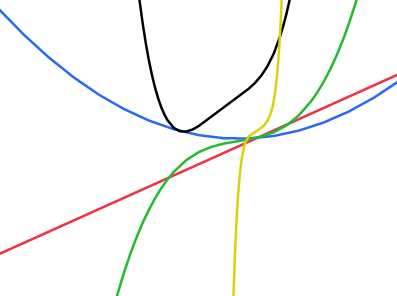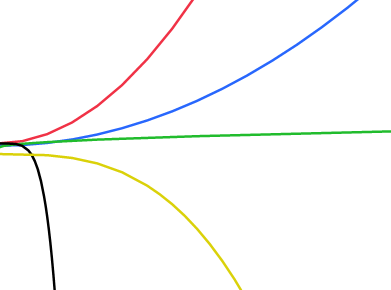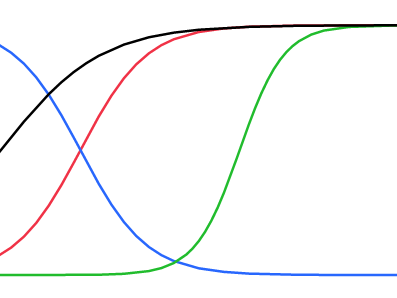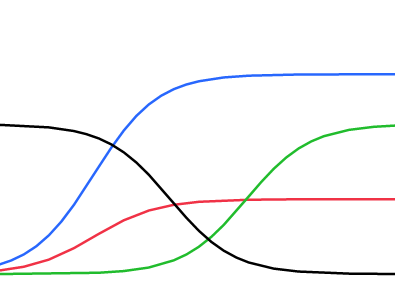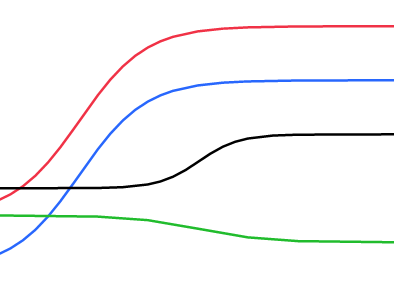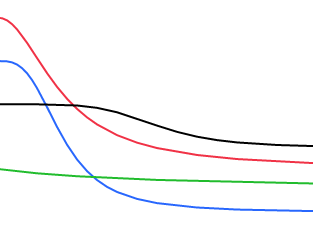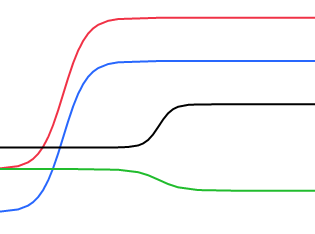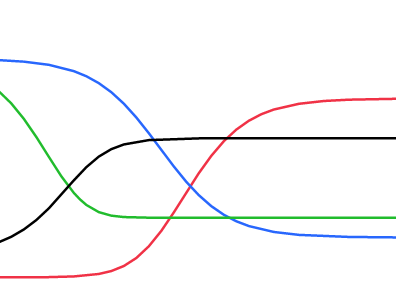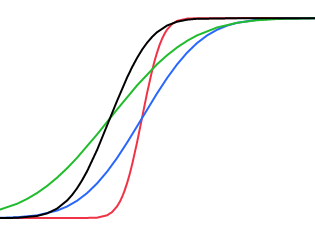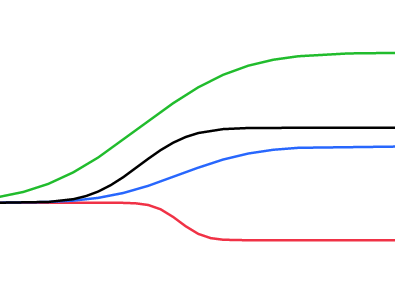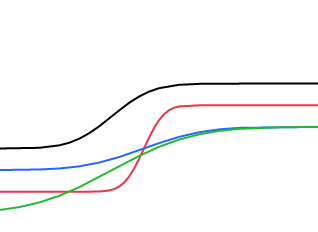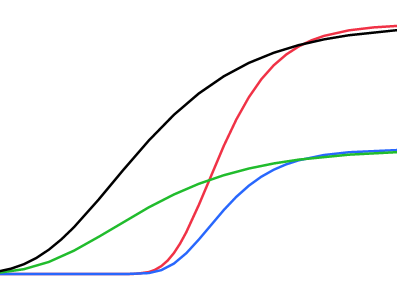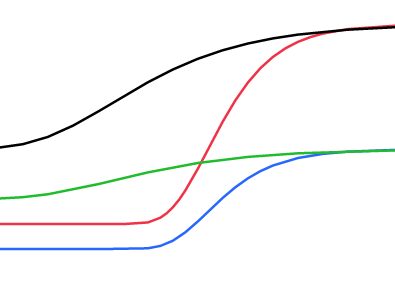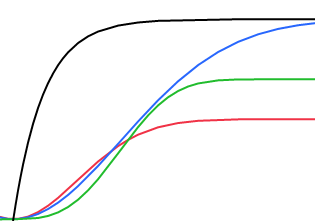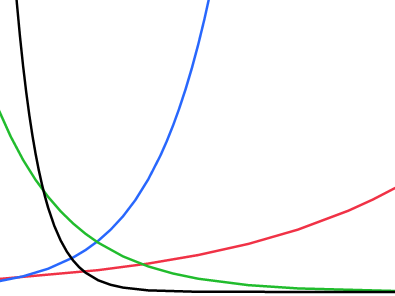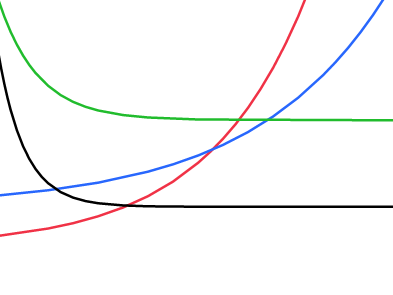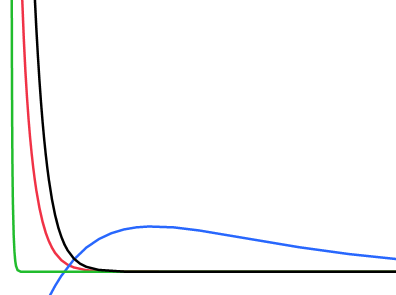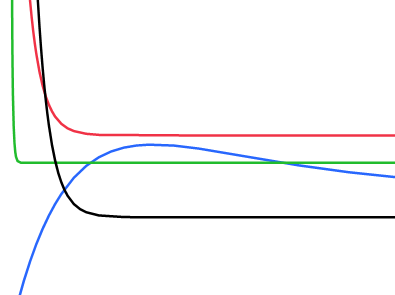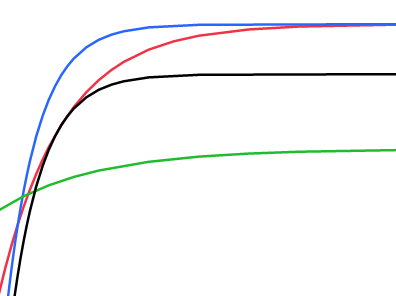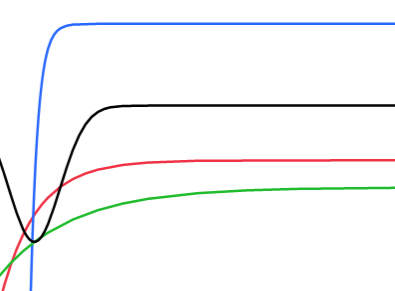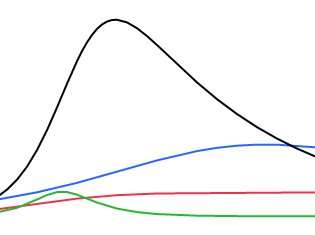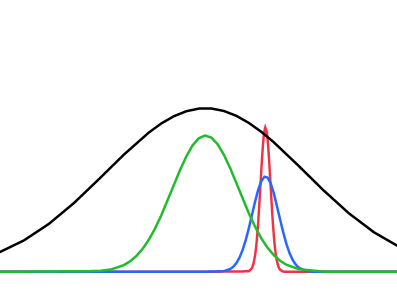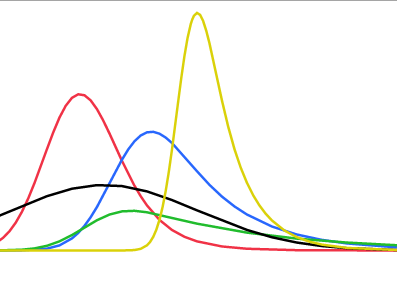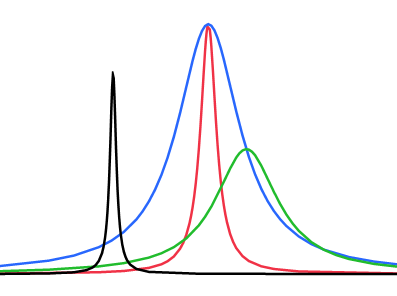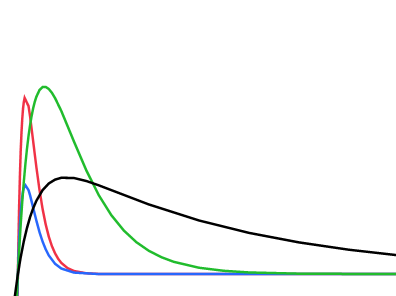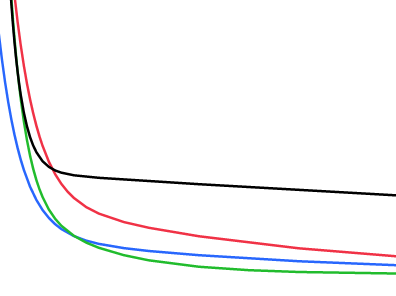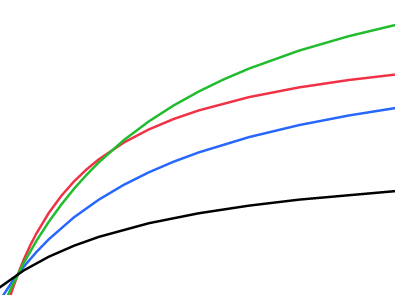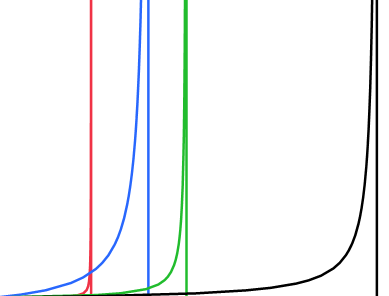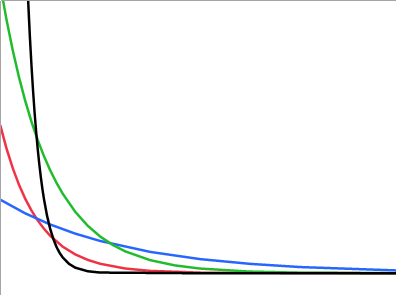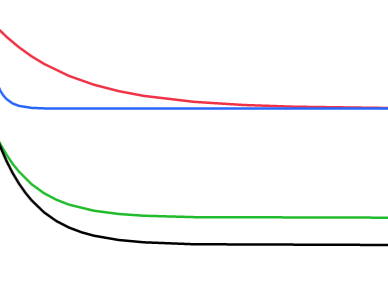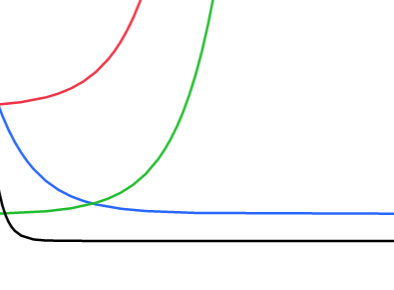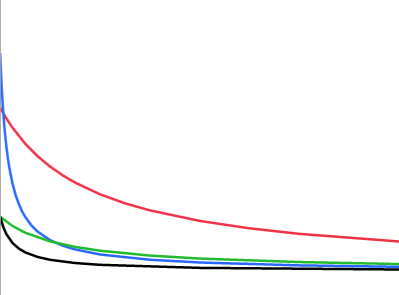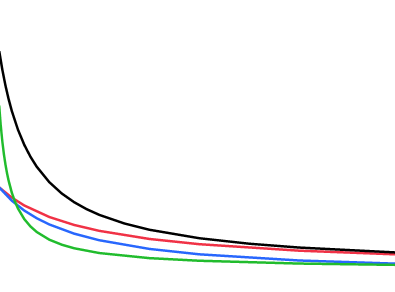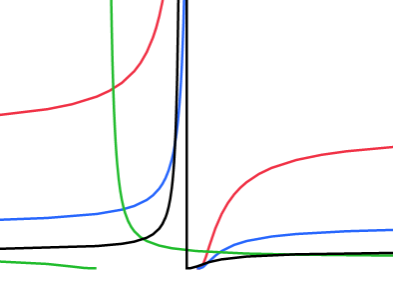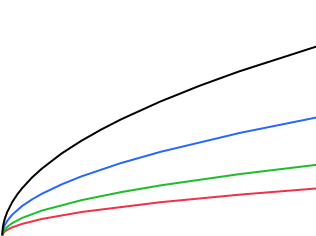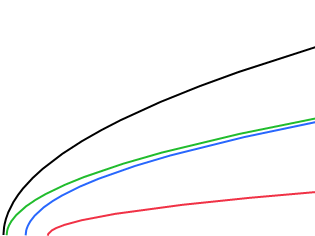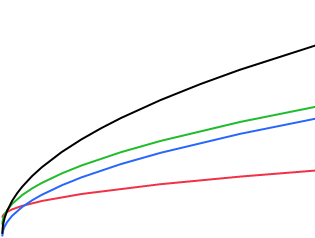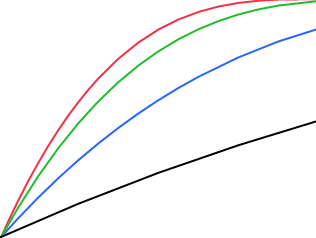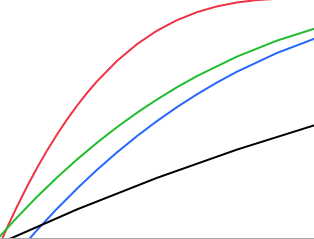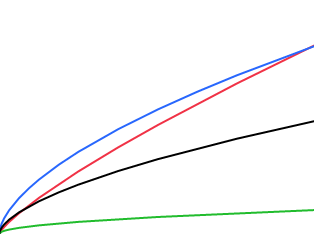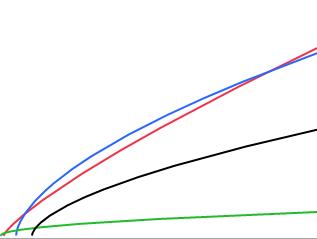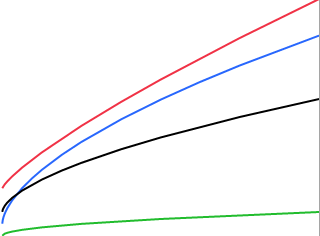Statistical Details for Fit Curve Models
The formulas for the models that are available in the Fit Curve red triangle menu are summarized in Table 14.1.
|
Model |
Formula |
|---|---|
|
Polynomials
|
where k is the order of the polynomial. These models can also be fit using the Fit Model and Fit Y by X platforms. |
|
Power Model
|
a = Intercept b = Slope c = Power Available only when both the response values and the x values are nonnegative. |
|
Logistic 2P
|
a = Growth Rate b = Inflection Point Available only when all response values are between zero and one. |
|
Logistic 3P
|
a = Growth Rate b = Inflection Point c = Asymptote |
|
Logistic 4P
|
a = Growth Rate b = Inflection Point c = Lower Asymptote d = Upper Asymptote |
|
Logistic 4P Rodbard
|
a = Growth Rate b = Inflection Point c = Lower Asymptote d = Upper Asymptote Available only when the x values are positive. |
|
Logistic 4P Hill
|
a = Growth Rate b = Inflection Point c = Lower Asymptote d = Upper Asymptote |
|
Logistic 5P
|
a = Growth Rate b = Inflection Point c = Asymptote 1 d = Asymptote 2 f = Power |
|
Probit 2P
|
a = Growth Rate b = Inflection Point Φ = Normal Distribution CDF Available only when all response values are between zero and one. |
|
Probit 3P
|
a = Growth Rate b = Inflection Point c = Asymptote Φ = Normal Distribution CDF There is also an asymptote at zero. |
|
Probit 4P
|
a = Growth Rate b = Inflection Point c = Lower Asymptote d = Upper Asymptote Φ = Normal Distribution CDF |
|
Gompertz 3P
|
a = Asymptote b = Growth Rate c = Inflection Point |
|
Gompertz 4P
|
a = Lower Asymptote b = Upper Asymptote c = Growth Rate d = Inflection Point |
|
Weibull Growth
|
a = Upper Asymptote b = Growth Rate c = Inflection Point Available only when both the response values and the x values are nonnegative. |
|
Exponential 2P
|
a = Scale b = Growth Rate |
|
Exponential 3P
|
a = Asymptote b = Scale c = Growth Rate |
|
Biexponential 4P
|
a = Scale 1 b = Decay Rate 1 c = Scale 2 d = Decay Rate 2 Available only when the response values are positive. |
|
Biexponential 5P
|
a = Asymptote b = Scale 1 c = Decay Rate 1 d = Scale 2 f = Decay Rate 2 |
|
Mechanistic Growth
|
a = Asymptote b = Scale c = Growth Rate |
|
Hybrid Exponential
|
a = Maximum b = Scale c = Rate d = Power Available only when both the response values and the x values are nonnegative. |
|
Cell Growth 4P
|
a = Peak value if mortality rate, d, is zero b = Response at time zero c = Cell Division Rate d = Cell Mortality Rate Available only when the response values are positive and the x values are nonnegative. |
|
Gaussian Peak
|
a = Peak Value b = Critical Point c = Growth Rate |
|
ExGaussian Peak (Exponentially Modified Gaussian Peak)
|
a = AUC (area under the curve) b = Location c = Scale d = Lambda φ = the standard normal pdf |
|
Lorentzian Peak
|
a = Peak Value b = Growth Rate c = Critical Point |
|
One Compartment Oral Dose
|
a = Area Under Curve b = Elimination Rate c = Absorption Rate Available only when the response values and the x values are all positive. |
|
Two Compartment IV Bolus Dose
|
α = β = a = Initial Concentration b = Transfer Rate In c = Transfer Rate Out d = Elimination Rate Available only when the response values and the x values are all positive. |
|
Michaelis-Menten
|
a = Maximum Velocity b = Michaelis Constant Available only when the response values and the x values are all positive. |
|
Inverse Michaelis-Menten
|
a = Maximum Velocity b = Michaelis Constant Available only when the response values and the x values are all positive. |
|
First Order Rate
|
a = Initial Value b = Rate Constant Available only if the x values are nonnegative. |
|
First Order with Limits
|
a = Initial Value b = Limiting Value c = Rate Constant Available only if the x values are nonnegative. |
|
First Order with Equilibrium
|
a = Initial Value b = Forward Rate c = Backward Rate Available only if the x values are nonnegative. |
|
Second Order
|
a = Initial Value b = Rate Constant Available only if the x values are nonnegative. |
|
Second Order with Two Components
|
a = Initial value b = Offset c = Rate Constant Available only if all x values are nonnegative. |
|
Antoine Equation
|
a = Component Specific Constant b = Component Specific Constant c = Component Specific Constant Available only when the response values are greater than 0. The vertical asymptote is at 10a. The horizontal asymptote is at −c. |
|
Higuchi
|
a = Release Constant Available only if all x and y values are nonnegative. |
|
Higuchi with Lag
|
a = Release Constant b = Time Lag Available only if all x and y values are nonnegative. |
|
Higuchi with Burst
|
a = Release Constant b = Burst Available only if all x and y values are nonnegative. |
|
Hixson-Crowell
|
a = Release Constant Available only if all x and y values are nonnegative. |
|
Hixson-Crowell with Lag
|
a = Release Constant Available only if all x and y values are nonnegative. |
|
Korsmeyer-Peppas
|
a = Release Constant b = Diffusional Exponent Available only if all x and y values are nonnegative. |
|
Korsmeyer-Peppas with Lag
|
a = Release Constant b = Diffusional Exponent c = Time Lag Available only if all x and y values are nonnegative. |
|
Korsmeyer-Peppas with Burst
|
a = Release Constant b = Diffusional Exponent c = Burst Available only if all x and y values are nonnegative. |
